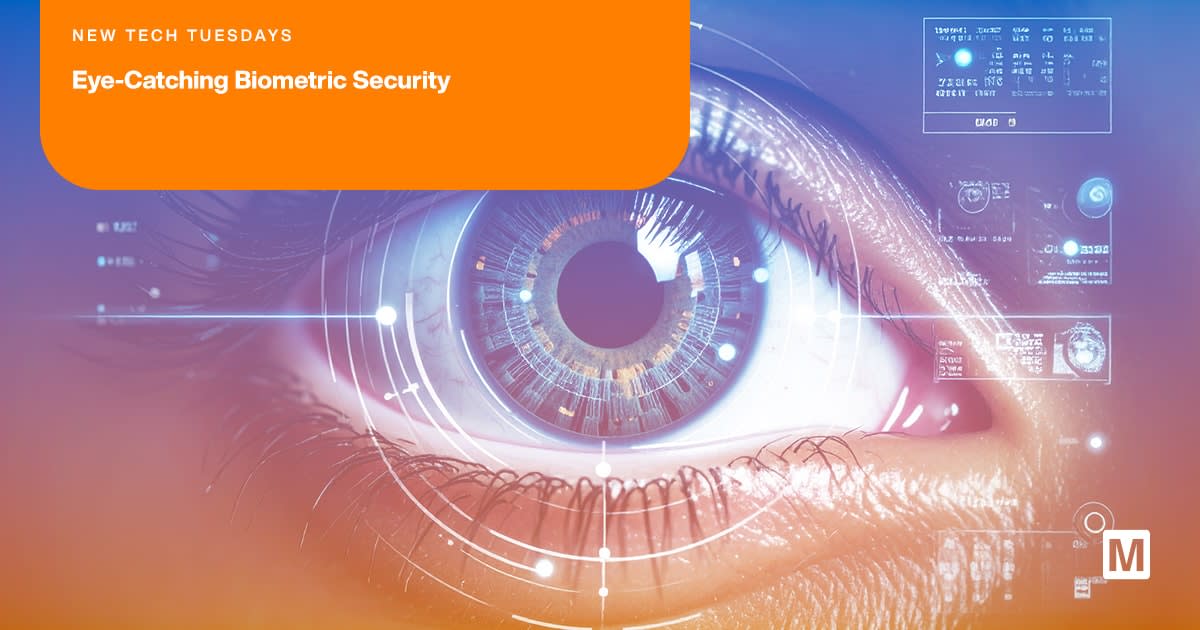Eye-Catching Biometric Security

New Tech Tuesdays
Join Mouser's Technical Content team for a weekly look at all things interesting, new, and noteworthy for design engineers.
Published July 8, 2025
Iris recognition as a means of biometric authentication is a fascinating technology since it can avoid false matches even in cross-comparisons across massive populations. It uses unique patterns in the colored part of the eye (the iris) to identify individuals. This biometric technology relies on the fact that every person's iris pattern is distinctive and remains stable throughout life, making it an extremely reliable and secure method for identification. In recent years, iris scanning has become more widely used in fields such as security, healthcare, and consumer technology. This week’s New Tech Tuesdays explores iris scanning and new sensor products that can help take the technology to new heights.
How Iris Scanning Works
Intricate patterns within the iris, such as furrows, crypts, rings, and freckles, are formed randomly during fetal development and are unique to each person. Even identical twins have different iris patterns.
Iris scanning technology captures a high-resolution image of the iris using an infrared camera. Infrared light illuminates the eye because it penetrates the iris more effectively than visible light, providing a clearer image of the detailed patterns. The captured image is then processed using specialized algorithms to map the unique features of the iris, creating a digital template.
This template is compared with a pre-existing database of iris templates for matching. The matching process is highly accurate, as the iris's features are stable over time and are not influenced by external factors such as aging or injury.
Iris Scanning Applications
Organizations that require high security standards increasingly view iris scanning as a reliable means of identification. The following examples show how these entities are incorporating the technology in their identification procedures.
- Security and access control: Iris scanning has become a popular tool in security systems for accessing restricted areas such as buildings, airports, and military installations.
- Mobile devices: Some modern smartphones and other mobile devices have integrated iris scanning technology as an added security feature. This lets users unlock their devices with a glance, providing a convenient alternative to traditional PINs or fingerprint scanners.
- Healthcare: Iris scanning can quickly and accurately verify patient identities, reducing the risk of medical errors and fraud.
- Border control: Many countries are adopting iris recognition as part of their entry and exit systems to speed processing times while maintaining security.
- Banking and financial services: Some financial institutions have started using iris recognition for secure access to accounts, ATMs, and mobile banking apps to help protect sensitive financial information from theft and fraud.
Challenges to Widespread Implementation
While iris scanning offers many benefits, its implementation does come with a few challenges. One of the main concerns is the privacy implications associated with collecting and storing biometric data. Since iris patterns are unique and permanent, unauthorized access to iris scan data could pose a significant privacy risk.
Additionally, the technology requires specialized hardware, such as infrared cameras, which can be expensive to implement, especially for large-scale systems. Environmental factors, such as lighting conditions, or certain medical conditions (e.g., cataracts) may also affect the accuracy of the scan.
The Newest Products for Your Newest Designs®
The AR0145CS Hyperlux™ SG digital image sensor from onsemi offers adaptability ideal for secure biometrics applications. These 1/4.3-inch CMOS sensors feature an active-pixel array of 1280 (H) × 800 (V) and are programmable through a simple two-wire serial interface (Figure 1).

Figure 1: The block diagram of the AR0145CS sensor solution. (Source: onsemi)
Also suitable for iris scanning and facial recognition technologies are onsemi AR0246 1/4-inch back-side illuminated (BSI) stacked CMOS image sensors. These advanced image sensors capture images in either linear enhanced dynamic range (eDR) or embedded high dynamic range (eHDR with 120dB) modes with a rolling-shutter readout. These enhanced image quality features open new possibilities for facial recognition applications like iris scanning.
Tuesday’s Takeaway
Despite privacy concerns and adoption challenges, ongoing technological advancements continually improve the accuracy, accessibility, and affordability of iris scanning systems. With the growing demand for secure authentication methods, iris scanning will likely continue to be integrated into various fields, becoming a standard method of identity verification.